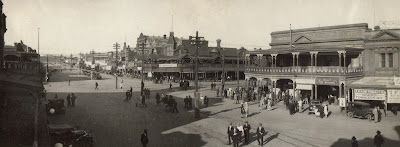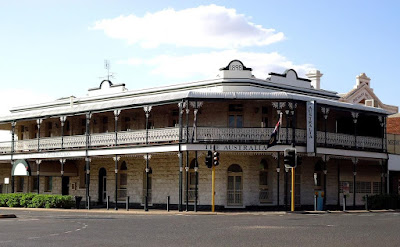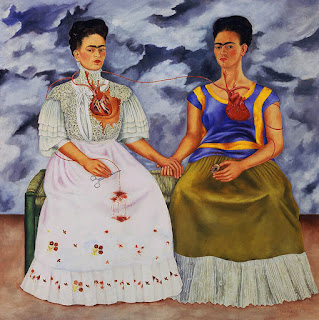For a city that stretches just 67sq km with a current population of 30,000+ people, the volume of pubs in Kalgoorlie was excessive.. and is now impressive. In the early 1900s, when the Goldfields were dominant, there were 93 hotels and 8 breweries in the town. C.Y O'Connor (1843-1902) was West Australia’s Chief Engineer who created the colony's railways, water supply, roads and harbours. Before O’Connor established the pipeline, water was scarce. Thankfully the miners believed that beer was cheaper, and much tastier, than water!
Most interesting pubs, architecturally-speaking:
1] The Kalgoorlie Hotel in Hannon St was designed in the Federation architectural style (built 1897) and is one of the oldest buildings with a balcony in town. After dark, Judd’s Pub is popular with regular live music and for touring bands. The name Judd refers to publican James Judd Mahony who ran the pub from the 1960s-80s.
2] Paddy’s Irish Bar at the Exchange Hotel (1900) was designed for the Wilkie Bros who were contractors for the Southern Cross to Kalgoorlie Railway line. The two complex storeys are made up of bricks, iron and a timber balustrade, a corner tower and corrugated galvanised iron gabled roof.
3] York Hotel opened in Feb 1901. Located over the road from the Govt Buildings Complex, this very ornate hotel was designed by Daniel Edmunds. He practised architecture in Kalgoorlie in 1899-1912 and was responsible for the City Markets. The eastern main entrance opened into a luxurious lounge hall, from which the main staircase led to the bedrooms above. Note the handsome circular dome for light, stamped metal ceilings and finely carved woodwork.
4] One of the city's most historic pub is the Palace Hotel (1897) in Hannan St, built for the huge sum of £17,000. Because the town was awash with gold money, Palace Hotel was designed to be the most luxurious hotel outside Perth, with its own electricity and water processing plant. This two-storey hotel was made from stone quarried from the local Ashlar quarries, and the furniture was supplied from Melbourne. With its prominent corner position in the town, the Palace Hotel has been the scene of many famous public speeches delivered from the balconies to the street.
One of the Palace Hotel’s regulars in its early days was Herbert Hoover (1874-1964), who as a young US mining engineer worked in the Goldfields for several years. Hoover had fallen for a local barmaid before he returned home to marry his love and to continue his mining career in China. Long before Hoover became the U.S President in 1929, his parting gift to the hotel was the elaborately carved mirror still in the foyer.
5] Boulder, now part of Kalgoorlie, has 8 pubs. Tattersalls was built as a two-storey hotel on a corner site, designed in my favourite Federation Filigree style c1890-c1915. The building once had a veranda and balcony that extended across the facades. The exterior features a balustraded parapet; and a triangular pediment that highlights the entrance and the arched sash windows. Importantly there is a bar named for the world-famous billiards star and Kalgoorlie local, Walter Lindrum (1898–1960).
6] Criterion Hotel was built in the Federation Free style, a small but important part of the Hannan St streetscape. Built to the footpath line with a balustraded parapet and highly decorative pediment, the timber veranda extends the length of the facade. It also has an unusual parapet and some leadlight glazing in the street frontage.
7] At a licensing court in June 1900, plans for the stunning Victorian Oriental Hotel on the corner of Cassidy and Hannan Sts were presented: a pub building with 12 bedrooms near the York Hotel. Some money for the construction came from the Wilkie Bros who built the rail line from Southern Cross to Kalgoorlie, enabling it to become Kalgoorlie’s most exotic architecture.
Because of high maintenance costs, The Oriental Hotel was to be demolished in 1972 to make way for a car park, but within hours an injunction was taken out; thousands of people had signed a petition to stop the destruction. Then fire erupted in the hotel and it could not be saved. Anger over the damage stopped further development.
The Kalgoorlie Race Riots started in Jan 1934 when miner-sportsman George E Jordan was twice ejected from the Hannans Hotel by Italian barman Claudio Mattaboni. When Jordan returned to the hotel the following day to fight Mattaboni, he fell, broke his skull and soon died in hospital. Rumours that Mattaboni had murdered Jordan sparked rioting, violence and looting of migrant-run facilities, the riots starting AT Hannans Hotel. The old Amalfi Restaurant was also burnt down.
Today the pubs are still flooded with miners (and tourists) after work, just as they were 120 years ago. And today Goldfields Tourism Network runs excellent pub tours in Kalgoorlie and Boulder.
Photo credits





















